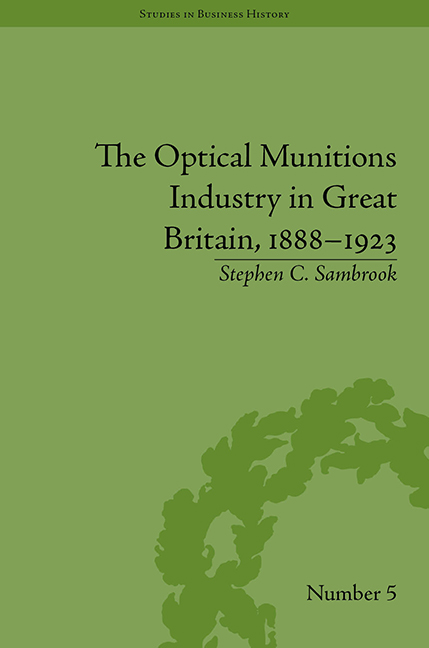Book contents
- Frontmatter
- CONTENTS
- Preface and Acknowledgements
- List of Figures and Tables
- List of Technical Terms
- Introduction
- 1 The Emergence of the Industry, 1888–99
- 2 The Growth in Importance from the Boer War to 1906
- 3 Expansion and Consolidation, 1907–14
- 4 The Impact of War, August 1914 to mid-1915
- 5 Industrial Mobilization: The Ministry of Munitions and its Relationship with the Industry
- 6 The Industry's Wartime, 1915–18
- 7 Industrial Demobilization and Implosion, 1919
- 8 Adaption and Survival, 1919–23
- Conclusion
- Notes
- Works Cited
- Index
Introduction
- Frontmatter
- CONTENTS
- Preface and Acknowledgements
- List of Figures and Tables
- List of Technical Terms
- Introduction
- 1 The Emergence of the Industry, 1888–99
- 2 The Growth in Importance from the Boer War to 1906
- 3 Expansion and Consolidation, 1907–14
- 4 The Impact of War, August 1914 to mid-1915
- 5 Industrial Mobilization: The Ministry of Munitions and its Relationship with the Industry
- 6 The Industry's Wartime, 1915–18
- 7 Industrial Demobilization and Implosion, 1919
- 8 Adaption and Survival, 1919–23
- Conclusion
- Notes
- Works Cited
- Index
Summary
This book describes and analyses the creation and growth of a successful technological and strategically vital manufacturing community in Britain whose story runs counter to perceptions of the general relative decline in British scientific and technological industries during the later nineteenth and early twentieth centuries. The optical munitions industry has remained largely unnoticed by historians, not least because of assumptions that its products were essentially little different from those of the general optical manufacturing sector. In fact, the optical munitions industry produced a highly specialized, increasingly sophisticated and complex group of products in response to other advancing technologies that not only influenced military and naval weapons design, but also the strategy and tactics of their use. These devices were specially designed or deliberately adapted for use in warfare and were used for a multiplicity of tasks, from observation and sighting individual weapons to controlling gunnery on land and at sea. They ranged from derivatives of the simple terrestrial telescope to highly complex and sophisticated apparatus such as the naval rangefinder and the submarine periscope, creations without which the principal strategic weapons of the First World War could not have functioned at all. This relatively small but highly specialized manufacturing sector attained a crucial degree of importance within the armaments industries so that its story adds substantially to the understanding of the performance of specialized technological manufacturing in Britain between the late nineteenth century and the mid-1920s.
- Type
- Chapter
- Information
- Publisher: Pickering & ChattoFirst published in: 2014



